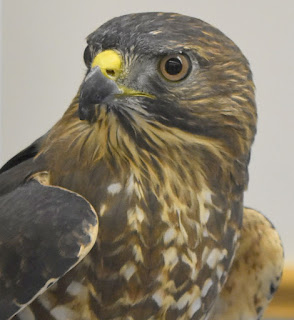I finally finished the book today and was so happy I read it. The author began illustrating natural history as a college freshman in 1976. This book visually documents her work and joy in rehabilitating birds, and shares through engaging writing about the history, characteristics, and personalities of the birds. It was liking reading the author's nature journal and diary for a number of years, and getting a glimpse into the many lives she has saved.
Below I've included photos that I've taken throughout the years of birds in our backyard interspersed with excerpts from The Bluebird Effect. The exceptions are the hawks and sandhill cranes. One of the photos of the hawks was taken at an event I hosted that benefited many non-profits and the other was taken at a wildlife preserve. The cranes were taken in nearby pastures.
Some of the things that I found interesting that she wrote about follow. These are some of the quotes or paraphrases from The Bluebird Effect:
- I thought about human intervention and the debates around bird feeding. I have colleagues who view bird feeding as the equivalent of turning wild birds into backyard pets.
- Knowledgeable bluebirders maintain that bluebirds don't need a mealworm subsidy to thrive and raise young.
- Where would bluebirds, as a species, be without human intervention? When the long-term decline of bluebirds became evident in the 1960s, the nationwide move to provide housing for them was the largest single-species conservation effort ever launched.
- Mozart kept a pet starling that could whistle parts of his concertos, with its own improvisations and additions. When it died, three years later, he held a funeral, with invited guests in full mourning dress.
- A study of Carolina chickadees showed that fully 7 percent more birds survive the winter when they have access to feeders. Like many birds, chickadees split their diet down the middle in winter, half being vegetable, the other half insects and their eggs. In summer, 90 percent of their sustenance derives from invertebrates.
- Could gratitude be part of a bird's emotional makeup? It was clear to me now that they could distinguish individual people and remember grievances and kindnesses alike.
- I began saving eggshells and baking them in a low oven until they started to brown around the edges, just to make sure they harbored no harmful bacteria from the eggs. Then I'd spread them on a big flat rock out in the yard, where the swallows had room to approach and take off.
- There are a lot of raptor rehabilitation facilities around but very few places that will take songbirds. The simplest reason is that raptors need to be fed once a day.
- Most of the songbirds that get in trouble are orphaned nestlings, and they need to be fed every twenty to forty-five minutes, dawn to dusk, for a period of weeks.
- An osprey's outer toe on each foot can swivel through 180 degrees, giving the bird a choice of a conventional three-toes-forward grip, or two forward, two back. This trait, called "functional zygodactylism," it shares with owls but with no other hawk.
- Sandhill cranes are legally hunted in 13 states in the United States, including Minnesota. In Canada, they can be hunted in Saskatchewan and Manitoba, and in Mexico, they're hunted in nine northern and central states. Minnesota implemented its season in 2010.
- Sandhill cranes, if it's extremely lucky, can raise only two young per year. The vast majority of lesser sandhill cranes with successful nests are able to raise only one "colt" per year.
- The sandhill crane has the lowest recruitment rate of any bird now hunted in North America. Recruitment rate is the percentage of any population that is replaced with new young birds in a given year.
- Cardinals have shallow twig nests in low bowers of bramble hung with honeysuckle or grapevine. Clutch size varies from one to five eggs, with an average of three in most nests.
- The northern cardinal's range has expanded dramatically since the early 1800s. At the turn of the twentieth century, cardinals were common in Pennsylvania and New Jersey, but stuck only a toe into southern New York.
- Cardinals colonized in the Twin Cities by 1930.
- The cardinal chicks' nesting period is only ten days after hatching. Their low, open-cup nests are so vulnerable to snakes and rodents that the shorter the time they're occupied, the better.
- Like it or not, we're feeding the sharp-shinned and the Cooper's hawk from our [bird] feeding stations, too - they're getting seed, metabolized into blood, bone, and feather.













No comments:
Post a Comment